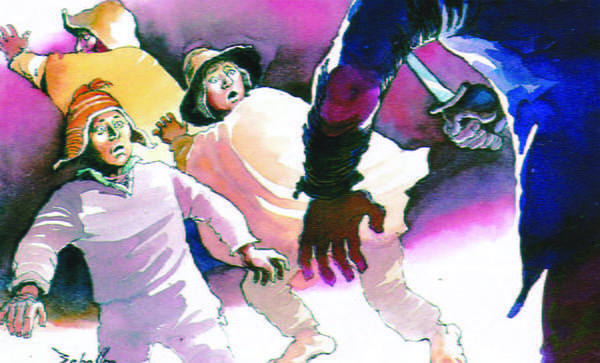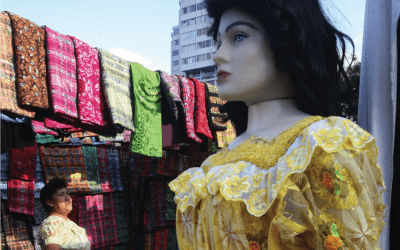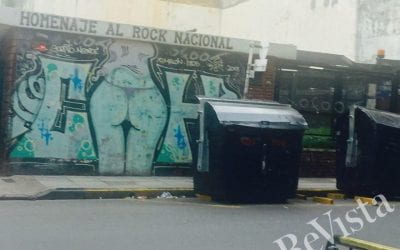Peruvian Pishtacos
Tales of Anti-Aging Cream and Other Rumors
News stories of captured drug gangs are so common in Peru that viewers barely noted the television appearance of three prisoners in November 2009. Police had captured the “gang” in the Huánuco jungle—a region known for narcotraffic and drug violence. Police regularly staged these press conferences with hundreds of kilos of half-processed cocaine paste piled like wheels of white cheese: the higher the piles, the more significant the drug bust.
But the Huánuco prisoners stood in front of an almost empty evidence table. Instead of the usual contraband, the table held two Inka Kola soda bottles filled with a yellow liquid too thick to be soda. It was human fat, the officer said, taken from a 27-year-old man that had gone missing that year. The gang allegedly lured the man to the jungle with a fake job offer, then killed him to sell his fat to a European cosmetics company. One prisoner confessed that he was told the company would pay $15,000 per liter for the fat. He said the company believed that human fat had the power to vanish wrinkles.
Police discovered the remains of the disappeared man’s body, and linked it to the prisoners. On television the police declared that the prisoners were part of a global fat-trafficking network operating in Peru. A manhunt was underway for the rest of the “gang,” including two Italians that the police claimed were wanted by Interpol.
For some Peruvian peasants whose bodies showed signs of hard work in the hot sun, the existence of a human fat face cream seemed plausible: it might explain the relatively fatter, less-wrinkled faces of Europeans and North Americans, for example. The story also makes more sense when seen in light of Andean myths. As the manhunt continued, the prosecutor and the public quickly dubbed the gang pishtacos—a kind of Andean monster that extracts fat from the bodies of indigenous people, either for its own consumption or as a primary material for certain industrial products.
Myths about the fat-sucking pishtaco circulated in South America during the Conquest. At the time pishtacos were depicted as white man, usually with a beard (like the Europeans of that time) and green or blue eyes—armed with a knife for butchering the body. The pishtacos supposedly extracted the fat of people who were not paying attention, drunkards or travelers who had lost their way, veering too far afield of the main village. The pishtaco would attack on the highways at night or in a hidden valley.
Pishtacos have some things in common with Western monsters. Like the vampire that must take human blood to live, pishtacos might need to consume human fat. But even in the colonial era pishtacos had an entrepreneurial streak. Indigenous people believed that the pishtacos used the fat to help Europeans make items that were beyond the ken of indigenous peoples at the time. For example, the tremendous metal bells tolling in every church in every plaza must have been made with a rare material like human fat. Even today some believe that some of this stolen human fat is needed to run new technology, from airplanes to laptop computers.
Anthropologists theorize that pishtaco rumors express deeply held beliefs about the structure of inequality and race in the Andes. Andrew Canessa and Mary Weismantel, for example, say that pishtacos are a symbol of racial anxieties. Since the pishtacos hover on the edge of the village, in the no-man’s-land between the more rural Quechua-speaking highlanders and the more urban mestizos, Canessa argues that the pishtacos’ violence serves as a warning of the more abusive side of white or mestizo elites. Parents warn their children about the terrible monster, scaring indigenous highland children into not straying too far outside the village.
The pishtaco’s focus on fat also has a unique connection to power in the Andes, one that expresses the exploitative relationship between indigenous peasants and the whiter world. The word for the origin deity, “Wiracocha,” can mean literally, a “lake of fat.” But “wira” could also be a term of respect for powerful, though feared, European land owners in the colonial era. Especially for peasants, body fat is a life force and source of survival in times of crop failure. Stealing fat then is a way of stealing the labor of that body. For indigenous people who survive by manual labor in Peru, the horrifying pishtaco figure expresses the inhumane conditions which powerful mestizos, whites and foreiginers force on indigenous bodies: first in the mines and fields of the Conquistadors and now for inadequate rights and compensation.
Rumors about pishtacos are also part of the way that marginalized people contest the social order that subordinates them. As James Scott has shown, rumors and conspiracy theories abound among subgroups of people in situations of drastic inequality—slaves, prisoners or peasants, for example. Such groups may not be able to speak openly about the abuse they experience from superiors due to the risk of punishment. Instead, they communicate in highly coded or veiled ways that become folklore. As white monsters, pishtacos are a shorthand for the seemingly irrational violence perpetrated on indigenous people by the white or mestizo elite. Rumors about pishtacos and beauty creams describe a world that presents an image of good and prosperity, but secretly maintains itself by consuming the fat of the world’s poor.
But just as rumors are used by subordinate groups, they can also be used by elites to dominate. Another interpretation of the beauty cream story might see pishtacos and other conspiracy theories as what Scott called the “arts of domination” — the useful tools for those in power to mislead the public and maintain the status quo. In the long run it was this last theory that was most likely to be part of the 2009 pishtaco scandal.
A few weeks after the police announced their arrests, their story unravelled. Plastic surgeons dismissed the idea that there was a demand for human fat, explaining that elite liposuction clinics in the rich neighborhoods of Lima had plenty of fat that no one needed. Transplant doctors wondered why the criminals so keen to make a profit on a human body would not harvest organs that were in high demand in the ilicit transplant market. Political analysts began to suspect the sensationalist “pistaco gang” was a a government created distraction. Stories of the monsters had already pushed news coverage of a state corruption scandal off the front page. Was that the intent all along?
In fact, police were only able to collect evidence that the “gang” killed one person. However, more than sixty people had mysteriously disappeared—a high number for a rural area. The missing people had been presumed dead, but their families had demanded an investigation. Peru’s state forces had a history of mass executions during the worst periods of political violence. Might the entire thing have been a coverup of state-sanctioned violence? Or were the disappeared victims of the drug cartels? If so, might police have lied to save face? What better cover up than to blame a gang of pishtacos? A few months later it was clear that the original story was a hoax. But the precise nature of the hoax has yet to be uncovered.
Anthropologist Nancy Scheper Hughes theorized that pishtaco stories, much like organ stealing rumors — tend to arise in times of peace, but after a violent conflict. These rumors attempt to explain and predict the kind of violence faced by peasants today. But they may also be used by the state to hide corruption or neglect, and further consolidate control over citizens.
Spring 2017, Volume XVI, Number 3
Caroline Yezer is an anthropologist and research associate at Clark University’s Strassler Center for Holocaust and Genocide Studies. She has published on gender, post-conflict reconciliation, and indigenous rights in Peru. Her coedited volume Formas del Recuerdo: Etnografías de Ayacucho Pasado y Presente was published by the Institute for Peruvian Studies in 2013.
Related Articles
Beauty: Editor’s Letter
Is it a confession if someone confesses twice to the same thing? Yes, dear readers, here it comes. I hate chocolate. For years, Visiting Scholars, returning students, loving friends have been bringing me chocolate from Mexico, Colombia, Venezuela, Ecuador, Peru…
Globalizing Latin American Beauty
Beauty seems to matter a lot in Latin America. Whenever I arrive in the region I am struck by the disproportionate number of attractive and stylish women and men who seem to be just walking around. I am always even more taken aback by airport bookstalls crammed with…
Beauty Weighs in Argentina
Argentines believe that “success” comes from luck and not as much from hard work and efforts, according to a recent survey conducted by the University of Palermo. This may work…






